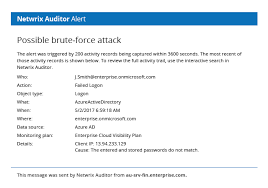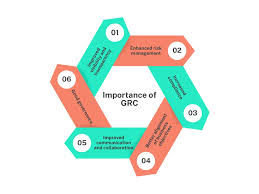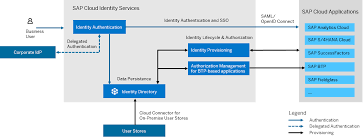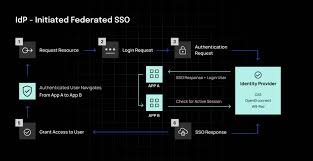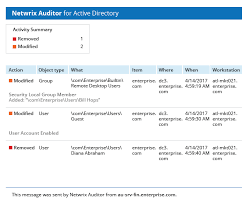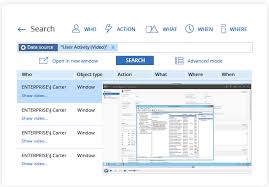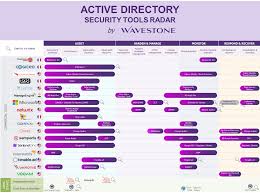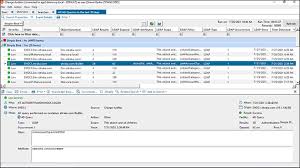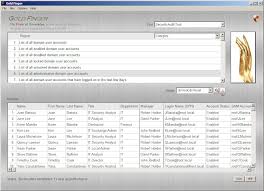The Comprehensive Guide to Netwrix Auditor for Active Directory
Netwrix Auditor for Active Directory is a powerful solution designed to streamline and enhance the auditing process of your Active Directory environment. With its robust features and user-friendly interface, Netwrix Auditor offers organisations a comprehensive way to monitor, analyse, and secure their Active Directory infrastructure.
Key Features of Netwrix Auditor for Active Directory:
- Real-time Monitoring: Gain instant visibility into all changes happening in your Active Directory, allowing you to detect suspicious activities promptly.
- Detailed Reports: Generate customisable reports that provide in-depth insights into user actions, group changes, permission modifications, and more.
- Audit Trail: Maintain a complete audit trail of all changes made within your Active Directory, ensuring accountability and compliance with regulatory requirements.
- Alerting Mechanisms: Set up alerts for critical events or deviations from established policies to take immediate action when necessary.
- Compliance Assistance: Simplify compliance with various regulations such as GDPR, HIPAA, and PCI DSS by leveraging pre-defined reports and audit templates.
Benefits of Using Netwrix Auditor for Active Directory:
By implementing Netwrix Auditor for Active Directory, organisations can experience a range of benefits that contribute to improved security posture and operational efficiency. Some key advantages include:
- Enhanced Security: Identify security gaps and mitigate risks by monitoring user activities and permissions within your Active Directory environment.
- Auditing Efficiency: Save time and resources by automating the auditing process and accessing detailed reports with just a few clicks.
- Informed Decision-Making: Make informed decisions based on real-time insights provided by comprehensive auditing data collected by Netwrix Auditor.
- Risk Mitigation: Proactively address potential threats and vulnerabilities before they escalate into security incidents that could compromise your organisation’s data integrity.
In Conclusion
In today’s rapidly evolving cybersecurity landscape, having a reliable auditing solution like Netwrix Auditor for Active Directory is essential for maintaining the security and integrity of your IT infrastructure. By leveraging its advanced features and capabilities, organisations can stay one step ahead of potential threats while ensuring compliance with industry regulations. Invest in the power of Netwrix Auditor for Active Directory to safeguard your organisation’s most critical assets effectively.
Enhance Security and Compliance: 8 Advantages of Netwrix Auditor for Active Directory
- Real-time monitoring of Active Directory changes
- Detailed reporting for in-depth analysis
- Maintains a complete audit trail of all modifications
- Customisable alerting mechanisms for critical events
- Simplifies compliance with regulatory requirements
- Enhances security by identifying and mitigating risks
- Increases auditing efficiency through automation
- Facilitates informed decision-making based on real-time insights
Seven Drawbacks of Netwrix Auditor for Active Directory: Challenges and Considerations
- Complex Configuration
- Resource Intensive
- Costly Licensing
- Limited Customisation
- Integration Challenges
- Steep Maintenance Requirements
- Support Limitations
Real-time monitoring of Active Directory changes
With its real-time monitoring capability, Netwrix Auditor for Active Directory offers organisations a proactive approach to cybersecurity by providing instant visibility into all changes occurring within the Active Directory environment. This feature allows administrators to promptly detect and respond to any suspicious activities, ensuring that potential security threats are identified and mitigated in real-time. By continuously monitoring user actions, group modifications, and permission changes, Netwrix Auditor empowers organisations to maintain a secure and compliant Active Directory infrastructure with heightened awareness and responsiveness to critical events.
Detailed reporting for in-depth analysis
With Netwrix Auditor for Active Directory, organisations benefit from a significant advantage in the form of detailed reporting for in-depth analysis. This feature allows administrators to generate customisable reports that provide comprehensive insights into user actions, group changes, permission modifications, and more within their Active Directory environment. By delving deep into the audit data through detailed reporting, organisations can identify trends, anomalies, and potential security risks, enabling them to make informed decisions and take proactive measures to enhance the overall security and compliance of their IT infrastructure.
Maintains a complete audit trail of all modifications
Netwrix Auditor for Active Directory offers the invaluable benefit of maintaining a complete audit trail of all modifications made within the Active Directory environment. This feature ensures that every change, whether it be user actions, group modifications, or permission adjustments, is meticulously recorded and easily accessible for review. By having a detailed audit trail at your fingertips, organisations can enhance accountability, trace back any changes to their source, and swiftly investigate any suspicious activities or security breaches. This proactive approach to auditing not only strengthens the overall security posture but also aids in regulatory compliance efforts by providing a transparent record of all modifications within the Active Directory infrastructure.
Customisable alerting mechanisms for critical events
Netwrix Auditor for Active Directory offers a valuable pro with its customisable alerting mechanisms for critical events. This feature empowers organisations to tailor alerts to specific parameters, ensuring that they are promptly notified of any significant deviations or suspicious activities within their Active Directory environment. By customising alerts, administrators can proactively address potential security threats, policy violations, or unusual user behaviours, enhancing the overall cybersecurity posture of the organisation. This proactive approach enables swift responses to critical events, ultimately strengthening the security and compliance measures in place.
Simplifies compliance with regulatory requirements
Netwrix Auditor for Active Directory offers a significant advantage by simplifying compliance with regulatory requirements. Organisations face increasing pressure to adhere to various industry regulations such as GDPR, HIPAA, and PCI DSS. By leveraging Netwrix Auditor’s pre-defined reports and audit templates, businesses can effortlessly demonstrate compliance with these standards. The solution automates the auditing process, providing detailed insights into user actions, group changes, and permission modifications that are crucial for meeting regulatory mandates. With Netwrix Auditor, organisations can streamline their compliance efforts, reduce the risk of non-compliance penalties, and ensure that their Active Directory environment meets the necessary regulatory standards efficiently and effectively.
Enhances security by identifying and mitigating risks
Netwrix Auditor for Active Directory stands out as a valuable asset in enhancing security by proficiently identifying and mitigating risks within your IT environment. By providing real-time monitoring and detailed reporting capabilities, Netwrix Auditor enables organisations to proactively detect potential threats and vulnerabilities. Through its robust alerting mechanisms and audit trail functionality, it empowers administrators to take swift action to address security gaps before they escalate. By utilising Netwrix Auditor for Active Directory, businesses can bolster their overall security posture and safeguard their critical assets effectively.
Increases auditing efficiency through automation
Netwrix Auditor for Active Directory offers a significant advantage by increasing auditing efficiency through automation. By automating the auditing process, organisations can save valuable time and resources that would otherwise be spent on manual monitoring and data collection. This automation streamlines the detection of changes and activities within the Active Directory environment, allowing for swift identification of potential security risks or compliance issues. With Netwrix Auditor’s automated capabilities, users can access detailed reports and insights with ease, empowering them to make informed decisions promptly and proactively address any audit-related challenges that may arise.
Facilitates informed decision-making based on real-time insights
Netwrix Auditor for Active Directory offers a significant advantage by facilitating informed decision-making based on real-time insights. By providing immediate visibility into user activities, group changes, and permission modifications within the Active Directory environment, organisations can access up-to-date data to make strategic decisions promptly. This capability not only enhances operational efficiency but also enables proactive responses to potential security threats or compliance issues. With Netwrix Auditor, businesses can confidently navigate complex IT landscapes and stay ahead of evolving challenges through data-driven decision-making.
Complex Configuration
One notable drawback of Netwrix Auditor for Active Directory is its complex configuration process, which may pose a challenge to users unfamiliar with its intricate setup options. The steep learning curve associated with configuring the software can potentially hinder the initial implementation phase and require additional time and resources to master. Organisations considering the adoption of Netwrix Auditor should be prepared to invest in training and support to effectively navigate the complexities of its configuration settings.
Resource Intensive
One notable drawback of Netwrix Auditor for Active Directory is its resource-intensive nature, particularly evident in larger environments. The solution’s demand for system resources can potentially lead to performance issues, affecting the overall efficiency of the IT infrastructure. Organisations operating on a significant scale may find themselves grappling with the challenge of balancing auditing requirements with maintaining optimal system performance when utilising Netwrix Auditor for Active Directory. It is crucial for users to consider and address this aspect to ensure a seamless and productive auditing experience without compromising system functionality.
Costly Licensing
One significant drawback of Netwrix Auditor for Active Directory is its costly licensing structure, which can pose a challenge for smaller organisations operating on limited budgets. The high licensing cost associated with this solution may deter some businesses from implementing it, potentially limiting access to its advanced auditing capabilities and security features. As a result, smaller organisations with financial constraints may find it challenging to justify the investment required to leverage the full benefits of Netwrix Auditor for Active Directory, impacting their ability to enhance their Active Directory security and compliance efforts effectively.
Limited Customisation
Users of Netwrix Auditor for Active Directory may encounter a drawback in the form of limited customisation options. In comparison to some other auditing solutions available in the market, the level of flexibility to tailor reports and settings according to specific preferences or requirements may be restricted. This limitation could potentially hinder users who seek highly customised audit reports or configurations to align more closely with their unique IT environment and auditing needs.
Integration Challenges
One notable drawback of Netwrix Auditor for Active Directory is the potential integration challenges it may present with certain third-party applications or systems. In some cases, connecting Netwrix Auditor to external platforms could require additional time and effort due to compatibility issues or complex configurations. This can result in delays in setting up comprehensive monitoring across all IT environments, impacting the seamless flow of data and potentially hindering the efficiency of auditing processes. Organizations considering the implementation of Netwrix Auditor should be prepared to address these integration challenges proactively to ensure a smooth and successful deployment.
Steep Maintenance Requirements
One notable downside of Netwrix Auditor for Active Directory is its steep maintenance requirements. The need for regular maintenance tasks, such as updates and patches, can be quite time-consuming and demanding, necessitating dedicated attention from IT personnel. Keeping the system up to date and ensuring it functions optimally may pose challenges for organisations with limited resources or busy IT teams. The commitment to ongoing maintenance can potentially impact operational efficiency and divert valuable time and effort away from other critical IT initiatives within the organisation.
Support Limitations
One notable drawback of Netwrix Auditor for Active Directory is the reported limitations in the responsiveness and effectiveness of customer support for technical issues. Some users have expressed concerns about encountering challenges when seeking assistance from Netwrix’s support team, leading to delays in resolving critical issues or receiving adequate guidance. This aspect can potentially impact the overall user experience and hinder prompt resolution of technical problems, highlighting the importance of addressing and improving support limitations to ensure a seamless customer support experience for all users.

